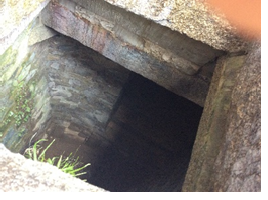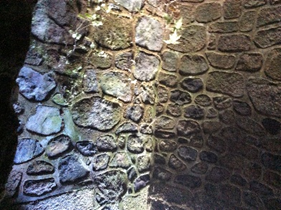Eco house in the Edo era The first part
Eco house in the Edo era, fish house in Nishiki market, and Iyomata’s well in 10 meters under ground (Now Tango Kingdom “Shoku-no-Miyako : Kyoto food” an antenna shop)
http://tango-kingdom-howto.com/en/
 |
The top view of Oriido (well)
|
| The wall in the well
|
A mysterious well where we can talk to people who is in the bottom descended from the top
The well water at Nishiki-Tenmangu, located in the east of Nishiki Koji, is refreshing and delicious. The Nishiki Market was created here owing to the well water.
It is said that Hideyoshi opened a market after the Japan unification, but it became a full-fledged fish market only in the Edo era. They made a cool room using cold air. This means that we have practiced thermodynamics using natural enthalpy as a storage. Based on this experience and insight, a fish and bird market has been established in Uoya-Cho. I think that the wisdom of storing natural ice in the ice room was also helpful.
Nishiki, located in the center of Kyoto, is a short distance from the Imperial Palace, and given the hot and humid Kyoto climate, Nishiki is a market that combines land, water, and cold. In summer, the temperature difference was about 10 degrees celsius compared with outside air.
The title of fish wholesaler is allowed from the Shogun during the Genwa period (1615-1623), and the names of towns such as Yaoya-cho, Uoya-cho and Nishiuoya-cho are written in the guidebook “Kyosuzume” of the Edo period.The merchant who had a store in Nishiki got a license from the official and had an exclusive business. It is reported that at the Imperial Palace events, each store in the market presented a same patterned plate for serving fish.
In 1770, the establishment of a greengrocer market (Standing Storekeeper sells things) in Nishikikoji Takakura was recognized by the magistrate’s office and they had prospered.
If you look at “Kyosuzume” from the Edo period, you can see that sazae, sea bream, octopus, sea cucumber, dried squid, sweetfish, eel and birds are sold. The well with preserved fish shown in Fig. 1 still exists in Iyomata (Fuyacho-Nishiki).
At that time, people went down the stairs to the bottom of the well, and suspended or floated a box with fish beside the groundwater in a large well space. Such ideas using natural energy will be a clue to solving environmental problems in the 21st century. From November 2019, it has been reopened as an antenna shop of Tango Kingdom for originating in food.
The Ori-ido (well) is not a well that only pumps up water, but it has two function one is for drinking and other is a storage space as a natural refrigerator. It is thought to have existed since the Heian era, and it is said that Komachi Onono had madeup by the surcface of water as a mirror
Energy savings since the Edo era and more former times include water sprinkling in summer, which is also called the wisdom of living, a bamboo blind, water fans, and wind chimes. The water fan was made in Gifu pre. during the Meiji era, and the fan was soaked in water and carried a cool breeze.


